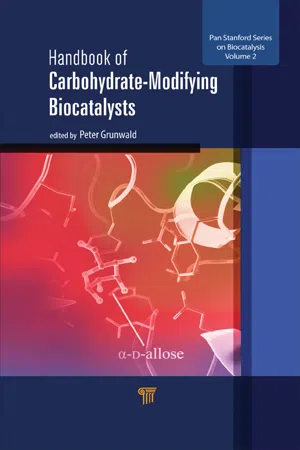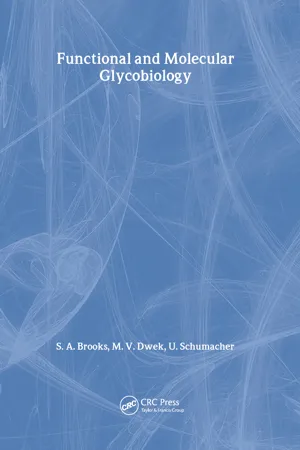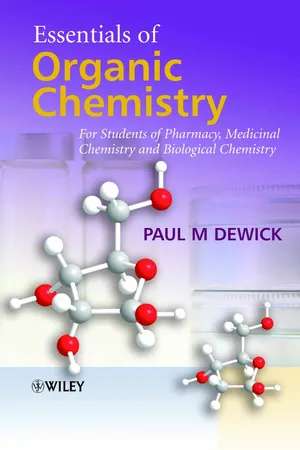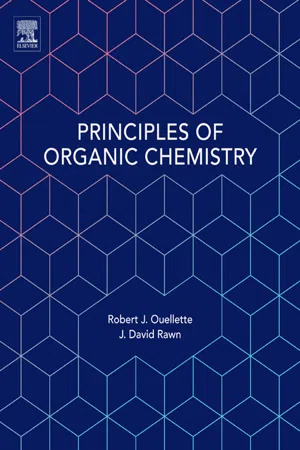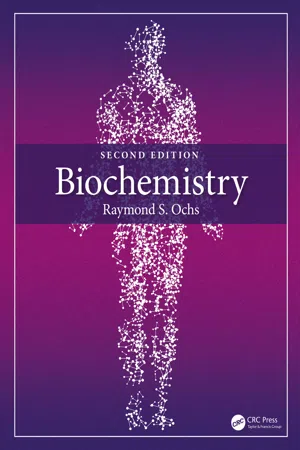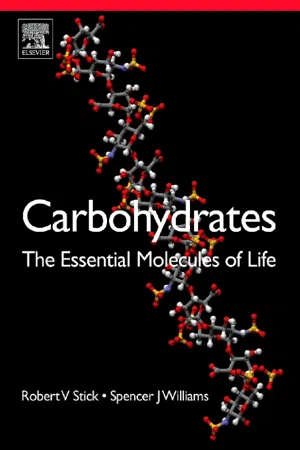Chemistry
Carbohydrates in nature
Carbohydrates are organic compounds found in nature, serving as a primary source of energy for living organisms. They are composed of carbon, hydrogen, and oxygen atoms, typically in a 1:2:1 ratio. In nature, carbohydrates are abundant in foods such as fruits, vegetables, grains, and legumes, and play essential roles in biological processes such as energy storage and structural support.
Written by Perlego with AI-assistance
Related key terms
11 Key excerpts on "Carbohydrates in nature"
- eBook - ePub
- Peter Grunwald, Peter Grunwald(Authors)
- 2016(Publication Date)
- Jenny Stanford Publishing(Publisher)
Chapter 1
Basics in Carbohydrate Chemistry
Heinrich Hühnerfuss Department of Organic Chemistry, University of Hamburg, D-20146 Hamburg, Germany [email protected]1.1 Introduction
The terms carbohydrate, saccharide, and sugar are being used as synonyms: carbohydrate refers to the classical assumption that this class of compounds exclusively consists of the elements C, H, and O, where the latter two elements exhibit the same relation as encountered in water, i.e., a relation of 2:1. Accordingly, a general formula of Cn (H2 O)n was derived which was actually in line with the formulae of several basic sugars such as glucose (C6 H12 O6 ) or ribose (C5 H10 O5 ). However, though more detailed structural studies revealed that these compounds did not contain intact water molecules, the term carbohydrates persists. Furthermore, it was shown that many natural carbohydrates contain additional elements, e.g., nitrogen or sulphur. Saccharide stems from the word sugar in several early languages (sarkara in Sanskrit, sakcharon in Greek, and saccharum in Latin).Carbohydrates are the most abundant class of bioorganic compounds in the biological world, making up more than 50% of the dry weight of the Earth’s biomass (Bruice, 2004). They play a crucial role in various functions in living organisms. For example, several carbohydrates serve as a major source of metabolic energy. Grass, leaves, fruits, seeds, stems, and roots of plants contain carbohydrates that plants use for their own metabolic needs and that also serve the metabolic needs of animals that eat the plants. Other carbohydrates can be found as structural components in cells or they act as recognition sites on cell surfaces. In the latter case, one of the most well-known phenomena is the approach of a sperm recognizing a carbohydrate on the surface of an egg’s wall. More examples highlighting the importance of carbohydrates in the world of bioorganic molecules will be given in Section 1.4 - eBook - ePub
- Dr Susan Brooks, Dr M Dwek, Udo Schumacher(Authors)
- 2023(Publication Date)
- Garland Science(Publisher)
1 An introduction to carbohydrate chemistry1.1 Introduction
Carbohydrates are the most abundant organic substances produced by living organisms. They form fuels, metabolic intermediates and energy stores. For many organisms, such as insects and plants, carbohydrate chains, such as chitin and cellulose, form the principle structural components. In all livings organisms, the two monosaccharides ribose and deoxyribose form part of the structure of the nucleic acids DNA and RNA in which sugar rings (deoxyribose and ribose, respectively) form the backbone to which the bases encoding the genetic information are covalently linked. Carbohydrates are also linked to proteins and lipids where they play important structural roles and are involved in many cell communication and signalling events.In spite of their biological importance, the characterization of carbohydrate structures, and the elucidation of their function, has lagged behind that of other major classes of biological molecules such as proteins and nucleic acids. There are several reasons for this. Carbohydrates are extremely heterogeneous in their size (ranging from a single monosaccharide to polysaccharides of up to 500 000 monosaccharide units), in their composition, and in the different linkages between the monosaccharide subunits, making their chemical and structural analysis challenging. Furthermore, their synthesis is not under direct genetic control, and therefore they are not amenable to the types of molecular biological analysis that have been so powerful in the study of proteins and nucleic acids.1.2 What are carbohydrates?
The name carbohydrate literally means a ‘hydrate of carbon’ and derives from their general formula, (CH2 O)n(where n is 3 or more). Although all carbohydrates could be described by this formula when the term was coined in the 19th century, today many substances which are classed as carbohydrates do not fit this general formula. Some are modified with nitrate, phosphate or sulfate groups and are still called carbohydrates. Other substances which do conform to this formula, such as lactic acid (C3 H6 O3 ), are not recognized as carbohydrates. - eBook - ePub
Essentials of Organic Chemistry
For Students of Pharmacy, Medicinal Chemistry and Biological Chemistry
- Paul M. Dewick(Author)
- 2013(Publication Date)
- Wiley(Publisher)
12
Carbohydrates
12.1 Carbohydrates
Many aspects of the chemistry of carbohydrates are not specific to this class of compounds, but are merely examples of the simple chemical reactions we have already met. Therefore, against usual practice, we have not attempted a full treatment of carbohydrate chemistry and biochemistry in this chapter. We want to avoid giving the impression that the reactions described here are something special to this group of compounds. Instead, we have deliberately used carbohydrates as examples of reactions in earlier chapters, and you will find suitable cross-references.Carbohydrates are among the most abundant constituents of plants, animals, and microorganisms. Polymeric carbohydrates function as important food reserves, and as structural components in cell walls. Animals and most microorganisms are dependent upon the carbohydrates produced by plants for their very existence. Carbohydrates are the first products formed in photosynthesis, and are the products from which plants synthesize their own food reserves, as well as other chemical constituents. These materials then become the foodstuffs of other organisms. The main pathways of carbohydrate biosynthesis and degradation comprise an important component of intermediary metabolism that is essential for all organisms (Chapter 15).The name carbohydrate was introduced because many of the compounds had the general formulaCx(H2 O)y , and thus appeared to be hydrates of carbon. The terminology is now commonly used in a much broader sense to denote polyhydroxy aldehydes and ketones, and their derivatives. Sugars or saccharides are other terms used in a rather broad sense to cover carbohydrate materials. Though these words link directly to compounds with sweetening properties, application of the terms extends considerably beyond this. A monosaccharide is a carbohydrate usually in the range C3 –C9, whereas oligosaccharide covers small polymers comprised of 2–10 monosaccharide units. The term polysaccharide - eBook - ePub
- Robert J. Ouellette, J. David Rawn(Authors)
- 2015(Publication Date)
- Elsevier(Publisher)
13Carbohydrates
13.1 Classification of Carbohydrates
If importance were measured by abundance, the carbohydrates would hold first prize, for they are far and away the most abundant molecules in the biological world (excepting only water). The functions of carbohydrates are as varied as their structures. They are a major source of metabolic energy, and are important structural components in plants and in animal cells. Carbohydrates are polyhydroxy aldehydes or ketones or compounds that can be hydrolyzed to form them. They span a wide range of structures, from molecules containing three carbon atoms to giant molecules containing thousands of carbon atoms.Carbohydrates are divided into three large structural classes—monosaccharides, oligosaccharides, and polysaccharides. Carbohydrates such as glucose and fructose that cannot be hydrolyzed into smaller molecules are monosaccharides .Carbohydrates consisting of 2–10 or so monosaccharides are oligosaccharides . Hydrolysis of oligosaccharides may yield identical monosaccharides or two or more different monosaccharides. Oligosaccharides are called disaccharides , trisaccharides , and so forth, depending on the number of linked monosaccharide units. The disaccharide lactose, also called “milk sugar,” contains one molecule of glucose and one of galactose. Maltose, another disaccharide, contains two glucose units.Polysaccharides contain thousands of covalently linked monosaccharides. Those that contain only one type of monosaccharide are homopolysaccharides . Examples include starch and cellulose that are made by plants and contain only glucose. Glycogen, found in animals, is a homopolysaccharide containing glucose. Polysaccharides that contain more than one type of monosaccharide are called heteropolysaccharides .The monosaccharides in oligo- and polysaccharides are linked by acetal or ketal bonds, which are called glycosidic bonds - eBook - ePub
MCAT Biochemistry Review 2024-2025
Online + Book
- (Author)
- 2023(Publication Date)
- Kaplan Test Prep(Publisher)
CHAPTER 4CARBOHYDRATE STRUCTURE AND FUNCTION
In This Chapter
4.1 Carbohydrate ClassificationNomenclature Stereochemistry 4.2 Cyclic Sugar Molecules Hexose Conformations Mutarotation 4.3 Monosaccharides Oxidation and Reduction Esterification Glycoside Formation 4.4 Complex Carbohydrates Disaccharides PolysaccharidesConcept SummaryCHAPTER PROFILE
The content in this chapter should be relevant to about 4% of all questions about biochemistry on the MCAT. This chapter covers material from the following AAMC content categories:1D: Principles of bioenergetics and fuel molecule metabolism5D: Structure, function, and reactivity of biologically-relevant moleculesIntroduction
Carbohydrates (or, as they are known colloquially, carbs) have experienced a tumultuous few decades in American culinary culture. Remember the food pyramid, which advised that we consume 6 to 11 servings of carbohydrates—in the form of bread, cereal, rice, and pasta—per day? Nowadays, we’re inundated with recommendations to cut down or even cut out carbs; still, carbohydrates make up most of the food and drink that continues to fill our refrigerators and cupboards. Whether or not this is healthy is debatable, as research on food choices continues. What is certain, however, is that carbohydrates are the most direct source of chemical energy for almost all organisms, ranging from single-celled protozoa to more complex organisms, such as plants and animals—including people.From a molecular standpoint, carbohydrates used to be defined by the empirical formula Cn(H2 O)n, but this definition is now considered antiquated. This formula only applies to simple monomeric sugars, which are also called monosaccharides. As simple sugars link to form complex sugars, water loss occurs, thus changing the empirical formula to Cn(H2 O)m - eBook - ePub
- Raymond S. Ochs(Author)
- 2021(Publication Date)
- CRC Press(Publisher)
4 CarbohydratesCarbohydrates are most commonly encountered as the sweetener sucrose and as starch, the nutrient of bread and pasta. The carbohydrates are literally hydrates of carbon, having the empirical formula (CH2 O)n . Because they possess both hydroxyl and carbonyl groups, they are a step up in complexity from lipids. Unlike lipids, carbohydrates are generally very soluble in water. The Latin word for sugar is saccharide; this is commonly used in the term polysaccharides. Sugars are nutrients for both animals and plants. Animals use sugars for rapid (i.e., minute-to-minute) energy production and lipids for long-term storage. Plants use sugars for energy exclusively, except at the seed stage. Sugars have greater weight than lipids, making them less suitable for long-term energy storage for organisms with mobile lifestyles (i.e., animals and seeds). The reason for the greater mass of sugars is two-fold. Sugars contain more oxygen atoms and are thus denser than lipids. Sugars also associate with water (through hydrogen bonding), further increasing their weight.Aside from providing energy, sugars have a wide variety of roles once they are chemically modified, such as cell–cell recognition and signaling. The specificity of blood group types derives from sugars attached to membrane lipids of red blood cells. Proteins secreted from cells are usually covalently linked to sugars. Thus, sugars are integral to biological function. We begin our study of sugars with the simplest ones: the monosaccharides.4.1 Monosaccharides
Monosaccharides have a single carbonyl group, which occurs at the first or second carbon atom. All remaining carbons have an attached hydroxyl group. There are two classes of monosaccharides: aldoses and ketoses. Aldoses (aldehydes) have the carbonyl at carbon one, whereas ketoses (ketones) have the carbonyl at carbon two.The “-ose” suffix (as in aldose and ketose) usually indicates that a compound is a sugar. The general category name for sugars is shown in Table 4.1 , starting with the smallest, the triose - Michael EJ Lean(Author)
- 2006(Publication Date)
- CRC Press(Publisher)
8Carbohydrates
Sugars Polysaccharides Carbohydrates in the diet Carbohydrates in the body Further readingCarbohydrates constitute one of the three main classes of ‘macro-nutrients’. They occur in food as sugars and starches, which are a major source of energy in the diet, and as cellulose which is the main non-starch polysaccharide.Sugars are produced in plants as the end product of photosynthesis, from carbon dioxide and water. At the same time oxygen is evolved, as shown in the equation for the formation of the simple carbohydrate glucose:6CO 2+ 12H 2O →+ 6GlucoseC 6H 12O 6O 2+ 6H 2OWater appears on both sides of this equation because it has been shown that all the oxygen evolved originates from the water. The oxygen atoms in the glucose and water molecules on the right-hand side of the equation are those which were originally combined with carbon in the carbon dioxide. The equation is a comparatively simple one, but it shows only the starting materials and final products of a series of complex reactions.The building-up of carbohydrate molecules by plants is accomplished by photosynthesis. Energy is required to transform the carbon dioxide and water into carbohydrates and this is supplied by the action of sunlight on chlorophyll in the leaves. Consequently, photosynthesis does not take place in the dark. Animals, including man, are unable to synthesize carbohydrates, and this is one of the fundamental differences between animals and plants. The sugars formed by photosynthesis are transported within the plant as sucrose, which is soluble in water. Sucrose is subsequently converted by the plant to polysaccharides, the most important of which are starch and cellulose. Starch is the principal energy reserve of most plants stored in tubers and elsewhere, whereas cellulose, which is the main component of plant walls, provides structural support and synthesized in growing plants of plants.- eBook - ePub
Dietary Supplementation in Sport and Exercise
Evidence, Safety and Ergogenic Benefits
- Jay Hoffman, Jay R Hoffman(Authors)
- 2019(Publication Date)
- Routledge(Publisher)
3Carbohydrate supplementation
From basic chemistry to real-world applications
Parker N Hyde, Richard A LaFountain and Carl M MareshIntroduction
Carbohydrates are organic compounds comprised of carbon, hydrogen and oxygen with a chemical formula commonly denoted as Cn (H2 O)n . Despite their overabundance in current dietary patterns, and a high rate of consumption worldwide, there is virtually no physiological necessity for carbohydrate consumption (77). In fact, the body’s daily carbohydrate requirements can be met by endogenous processes (10). As such, by definition carbohydrates are not essential nutrients. Therefore, this chapter will consider that all consumed carbohydrate serves as a supplement in the athletes’ arsenal to support desired performance outcomes.The goal of this chapter is to provide an evaluation of carbohydrate biochemistry, carbohydrate metabolism and carbohydrate supplementation for both training and competition applications.Carbohydrate biochemistry
Nomenclature
Carbohydrates are most often classified based on the number of saccharide units present. Monosaccharides and disaccharides are often referred to as “simple carbohydrates.” Monosaccharides are the simplest form of carbohydrate source. These carbohydrates do not tend to exist in an open form, rather they form ring-shaped structures in solution. When two monosaccharides are joined covalently a disaccharide is formed. The most common disaccharide is sucrose (i.e., table sugar), which is comprised of one glucose and one fructose molecule. Saccharide groups are connected by acetal bonds, or more commonly called glycosidic bonds . These covalent glycosidic bonds occur between the hydroxyl (-OH) groups of two monosaccharides while eliminating a water (H2 - eBook - ePub
Fundamentals of Biochemistry, Integrated E-Text with E-Student Companion
Life at the Molecular Level
- Donald Voet, Judith G. Voet, Charlotte W. Pratt(Authors)
- 2017(Publication Date)
- Wiley(Publisher)
CHAPTER 8 CarbohydratesChapter Contents
- Monosaccharides
- Monosaccharides Are Aldoses or Ketoses
- Monosaccharides Vary in Configuration and Conformation
- Sugars Can Be Modified and Covalently Linked
- Polysaccharides
- Lactose and Sucrose Are Disaccharides
- Cellulose and Chitin Are Structural Polysaccharides
- Starch and Glycogen Are Storage Polysaccharides
- Glycosaminoglycans Form Highly Hydrated Gels
- Glycoproteins
- Proteoglycans Contain Glycosaminoglycans
- Bacterial Cell Walls Are Made of Peptidoglycan
- Many Eukaryotic Proteins Are Glycosylated
- Oligosaccharides May Determine Glycoprotein Structure, Function, and Recognition
Approximately half the dry mass of corn (maize) kernels is starch, a polysaccharide that is broken down to glucose during digestion. Starch, along with the indigestible polysaccharide cellulose, is also the starting material for production of the biofuel ethanol.Carbohydratesorsaccharides(Greek: sakcharon, sugar) are the most abundant biological molecules. They are chemically simpler than nucleotides or amino acids, containing just three elements—carbon, hydrogen, and oxygen—combined according to the formula (C · H2 O)n, wheren ≥ 3. The basic carbohydrate units are calledmonosaccharides. There are numerous different types of monosaccharides, which, as we discuss below, differ in their number of carbon atoms and in the arrangement of the H and O atoms attached to the carbons. Furthermore, monosaccharides can be strung together in almost limitless ways to formpolysaccharides.Until the 1960s, carbohydrates were thought to have only passive roles as energy sources (e.g., glucose and starch) and as structural materials (e.g., cellulose). Carbohydrates, as we will see, do not catalyze complex chemical reactions as do proteins, nor do carbohydrates replicate themselves as do nucleic acids. And because polysaccharides are not built according to a genetic “blueprint,” as are nucleic acids and proteins, they tend to be much more heterogeneous—both in size and in composition—than other biological molecules. - Shilin Chen, Andrew Marston, Hermann Stuppner, Shilin Chen, Andrew Marston, Hermann Stuppner(Authors)
- 2014(Publication Date)
- Wiley(Publisher)
18 Analysis of Plant Oligo- and PolysaccharidesWolfgang BlaschekDepartment of Pharmaceutical Biology, University of Kiel, Kiel, Germany1 Introduction
Carbohydrates represent the major organic substance on earth. They are mainly built in the process of photosynthesis by cyanobacteria and aquatic and land plants. Carbohydrates are structural elements of nucleic acids (DNA and RNA), some coenzymes (e.g., NAD(P)H and ATP), glycoproteins, and many secondary products (e.g., flavonoid glycosides, anthraquinone glycosides, and cardiac glycosides). Most plants use carbohydrates, especially the disaccharide sucrose to transport energy (in the phloem). Carbohydrates can bear information in molecular or cellular recognition. The bulk of carbohydrates in plants, however, are storage polysaccharides (e.g., starch and fructans) or cell wall polysaccharides (e.g., pectins, hemicelluloses, and cellulose) (Nishinari et al., 2007; Fry, 2011).Monosaccharides are the basic structural unit of oligo- and polysaccharides. The most common monosaccharides occurring in oligo- and polysaccharides are arabinose and xylose (pentoses); glucose, galactose, mannose, and fructose (hexoses); rhamnose and fucose (6-deoxy hexoses); and galacturonic acid and glucuronic acid (hexuronic acids).Disaccharides are carbohydrates in which two monosaccharide units are joined by a glycosidic linkage.Oligosaccharides by definition contain up to 10 monosaccharide residues joined by glycosidic linkages. According to the number of monosaccharide residues, they are trisaccharides, tetrasaccharides, pentasaccharides, and so on and then have a degree of polymerization (DP) of 3, 4, 5, and so on, respectively. Oligosaccharides may be linear, branched, or even cyclic (cyclodextrins). For oligosaccharides, a defined structure can be given.Some examples for common plant di- and oligosaccharides are given in Table 1 .Table 1- eBook - ePub
- Robert V. Stick, Spencer Williams(Authors)
- 2010(Publication Date)
- Elsevier Science(Publisher)
Chapter 1. The ‘Nuts and Bolts’ of Carbohydrates
The Early Years
A Bunsen (1811–1899) burner, a Claisen (1851–1930) flask, a Liebig (1803–1873) condenser, an Erlenmeyer (1825–1909) flask, a Büchner (1860–1917) funnel and flask, all common tools for the practising chemist and also a reflection of the origins of much of the chemistry of the nineteenth century – Europe and, in particular, Germany. Although the name of Emil Fischer[a ]never graced a piece of apparatus, it became deeply embedded in the same period, so much so that Fischer is considered by many to be the pioneer of organic chemistry and biochemistry and, undoubtedly, the father of carbohydrate chemistry.[1,2 ]a Emil Hermann Fischer (1852–1919), Ph.D. (1874) under von Baeyer at the University of Strassburg, professorships at Munich, Erlangen (1882), Würzburg (1885) and Berlin (1892). Nobel Prize in Chemistry (1902).What exactly is a carbohydrate? As the name implies, an empirical formula C·H2 O (or CH2 O) was often encountered, with molecular formulae of C5 H10 O5 and C6 H12 O6 being the most common. The appreciable solubility of these molecules in water was commensurate with the presence of hydroxyl groups, and there was often evidence for the carbonyl group of an aldehyde or ketone. These polyhydroxylated aldehydes and ketones were termed aldoses and ketoses, respectively, with the more common members referred to as aldopentoses/aldohexoses and ketopentoses/ketohexoses. Very early on, it became apparent that larger molecules existed that could be converted, by hydrolysis, into smaller and more common units – monosaccharides from polysaccharides
Learn about this page
Index pages curate the most relevant extracts from our library of academic textbooks. They’ve been created using an in-house natural language model (NLM), each adding context and meaning to key research topics.
